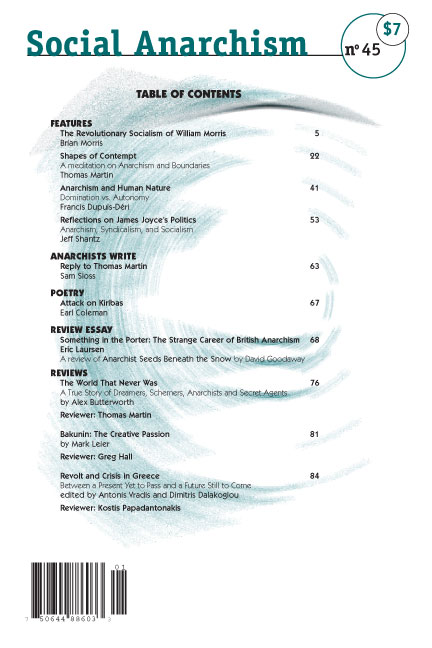Shapes of Contempt
a meditation on anarchism and boundaries
Page: 4
towards an anarchist theory of boundaries
The ‘classical’ anarchists – Bakunin, Godwin, Malatesta and the like – were not much concerned with the intimate link between anarchism and geography. Peter Kropotkin and Élisée Reclus were the great exceptions, and are now rightly regarded as the forerunners of an ecologically informed postmodern anarchism.[i] Both men sought to put anarchism on a scientific basis, and both recognized – a radical notion at the time! – that human society is not separate from, but intimately bound up with, the lives of all other species, and with the slow but inexorable evolution of the planet. Both understood that Darwin’s revolutionary theory had been hijacked by the (for want of a better word) Establishment. Yes, Reclus wrote, might does make right: but
When the miserable and disinherited of the earth shall unite in their own interest, trade with trade, nation with nation, race with race; when they shall fully awake to their sufferings and their purpose, doubt not that an occasion will assuredly present itself for the employment of their might in the service of right; and powerful as may be the Master of those days, he will be weak before the starving masses leagued against him. To the great evolution now taking place will succeed the long expected, the great revolution.[ii]
The absurdity of Europe’s political boundaries was a favorite target of Reclus. He looked at geography as both synchronic and diachronic: the relationships between people, and between peoples and their environments, change constantly across space and time. Precise boundaries are thus outdated almost as soon as they are drawn. Reclus describes human society in terms that foreshadow modern systems theory: social equilibrium is dynamic, maintained by the reciprocity between society’s needs and individual initiative. Society is an ‘open system’ (in the theory’s terminology), and open systems exchange matter and energy with their environment and with other systems – hence their boundaries are arbitrary, assigned by the observer for convenience of description. Geography for Reclus meant human geography, and human society meant evolution towards revolution.
Reclus was inevitably friendly with Peter Kropotkin: they shared the same political and scientific interests. The state, Kropotkin suggested, seeks to dissolve or override all forms of social organization so that each isolated individual is connected to other individuals only through allegiance to the sovereign authority. Voluntary associations are tolerated only so long as they support the state’s mission, or at least do not conflict with it – as Bodin put it, there must be no imperium in imperio. This centralizing project is bound to fail eventually because society precedes individuality: human nature is social and cooperative, and the competitiveness forced on us by the state is unnatural. It is no coincidence, according to Kropotkin, that symbiotic human society reached its zenith in the autonomous medieval city, just before the imposition of the Westphalian order. The medieval city was unconcerned with boundaries; it thrived on the exchange of goods and services across dynamic networks. More often than not, the city was walled: this naturally meant very obvious boundaries; but the walls were intended to keep the enemies of freedom out, not to imprison the inhabitants. The latter thought of their town as a commune – it was common property – Latin communis, a word best translated as “share together.” The IE root is *mei-“ which generates a family of words referring to exchanges: permeate, transmute, mutual, municipal, remunerate; but also amoeba (a creature with no fixed boundaries) and madness (a state in which the usual social boundaries are transgressed). In The State: Its Historic Role, Kropotkin is at pains to distinguish ‘the state’ from society and from government (the italics are in the original):
The State idea . . . . not only includes the existence of a power situated above society, but also of a territorial concentration as well as the concentration in the hands of a few of many functions in the life of societies. It implies some new relationships between members of society which did not exist before the formation of the State. A whole mechanism of legislation and of policing has to be developed in order to subject some classes to the domination of others.[iii]
He goes on to point out that medieval guilds, and corresponding organizations in other cultures, “extend beyond the boundaries of the hamlet; they extend far and wide into the desert and to foreign cities;” but that some of these groups inevitably seek to dominate the others, and so the sovereign state evolves. (Kropotkin never denies that human beings can be competitive as well as cooperative.) For a time the kings and princes tolerated these free communes, because it was profitable to do so. At times the cities had to fight for their independence, sometimes hiring one feudal lord to use his troops against another.
In the commune, the struggle was for the conquest and defence of the liberty of the individual, for the federative principle for the right to unite and to act; whereas the States' wars had as their objective the destruction of these liberties, the submission of the individual, the annihilation of the free contract, and the uniting of men in a universal slavery to king, judge and priest - to the State.[iv]
The Westphalian system had to incorporate and subjugate these cities within the state; and Kropotkin does not fail to note that state control of education has been telling us ever since that the subjugation was natural and necessary, a forward step in the evolution of human society.
As we all know, Kropotkin has been the most important of the ‘classical’ anarchists to today’s ecologically-infused anarchist movement, thanks largely to Murray Bookchin. This greatest of all twentieth-century anarchist thinkers has little or nothing to say about boundaries as such, but his call to dismantle all forms of hierarchy and domination assumes the dissolution of artificial boundaries of all sorts. As John Clark demonstrates, his philosophy of social ecology is entirely consonant with bioregionalism, though Bookchin wrote very little on the subject. “There are two fundamental social ecological principles that essentially define a bioregional perspective,” Clark writes. “One is the recognition of the dialectic of nature and culture, in which the larger natural world is seen as an active co-participant in the creative activities of human beings. The other is the principle of unity-in-diversity, in which the unique, determinate particularity of each part is seen as making an essential contribution to the unfolding of the developing whole.”[v] Of course Bookchin was always vehemently opposed to deep ecology, which does not disagree with these principles but takes them further into the realm of a radical reformulation of human culture and society. His main concern was that the sort of world the deep ecologists wanted would dislodge human beings from the center of human society. Though he understood better than anyone the need for anarchism to be ecological, Bookchin was more interested in the overhaul of the city, its integration with the countryside, and late in life even preferred to call himself a ‘municipal libertarian’ rather than an anarchist. Still, all of his work consistently implies a rejection of all artificial and/or permanent boundaries as restraints on the freedom of the individual and the natural evolution of society.
A few anarchist thinkers have also explored the implications of spatial logic and spatial social theory for anarchist philosophy. Shaun Huston applies Anthony Giddens’ time-space distanciation and David Harvey’s time-space compression models to the work of Kropotkin and Reclus, concluding that the control of social spaces by the ruling class aids the centralization of power and the fracturing of group solidarity. Huston’s point is that the shrinking of social space in recent centuries (progression from travel on horseback to jet planes, for instance) is experienced in very different ways by different social classes, contributing to the sort of social atomization that a centralized nation-state requires of its subjects.[vi] While explorations in this direction have considered boundaries only indirectly, they reinforce the evolving interpenetration of anarchism and ecology.
Footnotes
-
[i] Graham Purchase has explored this first stage of eco-anarchism in Anarchism and Ecology (Montréal: Black Rose, 1997).
-
[ii] Élisée Reclus, Evolution and Revolution, London: W. Reeves (1891), Seventh Edition.
-
[iii] Peter Kropotkin, "The State: Its Historic Role," London: Freedom Press, 1946, originally published 1897, Section I.
-
[v] John Clark, “Municipal Dreams : A Social Ecological Critique of Bookchin’s Politics” (4), at http://raforum.info/spip.php?article1041
-
[vi] Shaun Huston, "Kropotkin and Spatial Social Theory: Unfolding an Anarchist Contribution," Anarchist Studies, vol. 5, no. 2 (October 1997), 109-130.

